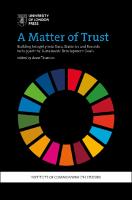A Matter of Trust
Building Integrity into Data, Statistics and Records to Support the Achievement of the Sustainable Development Goals
Contributor(s)
Thurston, Anne (editor)
Collection
Knowledge Unlatched (KU)Language
EnglishAbstract
The United Nations Sustainable Development Goals initiative has the potential to set the direction for a future world that works for everyone. Approved by 193 United Nations member countries in September 2016 to help guide global and national development policies in the period to 2030, the 17 goals build on the successes of the Millennium Development Goals, but also include new priority areas, such as climate change, economic inequality, innovation, sustainable consumption, peace and justice. Assessed against common agreed targets and indicators, the goals should facilitate inter-governmental cooperation and the development of regional and even global development strategies. However, each goal presents considerable challenges in terms of collecting and analysing relevant data and producing the statistics needed to measure progress. Most governments in lower resourced countries simply do not yet have the systems and controls in place to produce high quality, reliable data and statistics, and it is questionable whether the quality and integrity of the available information is adequate to support meaningful decisions and set direction for the future. There are substantial implications: where progress cannot be measured accurately because of inadequate or flawed statistics, the result can be misguided decisions, doubts about achievement of the goals and significant wasted resources. Getting statistics ‘right’ depends upon the quality and integrity of the data used to produce them and on the quality of the processes for collecting, manipulating and analysing the data. Without a documentary records as evidence of how the data were gathered and analysed or how statistics were produced and disseminated, it is not possible to confirm that the statistics are complete, accurate and relevant. Various global organisations do recognise the importance of high quality data and statistics for measuring the SDG indicators reliably, but there has been little attention to the role of records in providing the evidence needed to trust the data and statistics. There is, moreover, a lack of awareness that digital information simply will not survive without policies and procedures to manage and preserve it through time. As a result, digital data, statistics and records are being lost regularly on a large scale, particularly in lower resource countries, where the structures needed to protect and preserve them are not yet in place. This book explores, through a series of case studies, the substantial challenges for assembling reliable data and statistics to address pressing development challenges, particularly in Africa. Hopefully, by highlighting the enormous potential value of creating and using high quality data, statistics and records as an interconnected resource and describing how this can be achieved, the book will contribute to defining meaningful and realistic global and national development policies in the critical period to 2030.
Keywords
data; humanitarian work; United Nations; statistics; infographics; data collection; corruptionDOI
10.14296/1220.9781912250356ISBN
9781911507475, 9781912250349, 9781912250431Publisher
University of London PressPublisher website
https://uolpress.co.uk/Publication date and place
2020Imprint
University of London PressClassification
Data capture and analysis
Agriculture and farming


 Download
Download